By Mike Tanner, Photos By Steve Dandy
GRANDY, NC -- The road to North Carolina's Outer Banks is lined with piney woodlands and farm fields, along with numerous produce stands promising a bounty of fresh fruits and vegetables to passersby. In the town of Grandy, right next to a particularly well-stocked roadside market with a genuinely friendly staff, you'll discover the entrance to The Carolina Club.
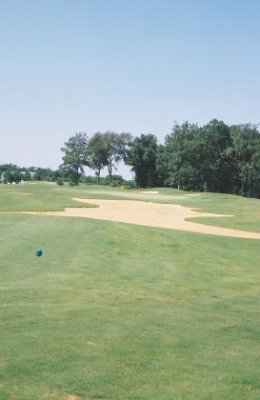 |
| A Sahara-like sweep of sand provides a visual threat on the 194-yard, par-3 second hole. |
The farm that once occupied these acres of manicured fairways and greens has been transformed into a tournament caliber golf course, but you can still see a reminder of its agricultural heritage.
"When the course opened in 1998, the pro shop was located in the farm house between the first hole and the main road," explained Doug Kinser, The Carolina Club's former head golf professional. "The staff operated from there for about two years. Now I think someone who lived in the house as a child has purchased it and is living there."
At the time, Kinser was an assistant pro at The Pointe, The Carolina Club's sister course, which is also owned by the group headed by United Turf's Keith Hall. Kinser left The Pointe to take the top job at The Carolina Club in January 1999 and has since moved back to The Pointe, where he is currently the head golf professional.
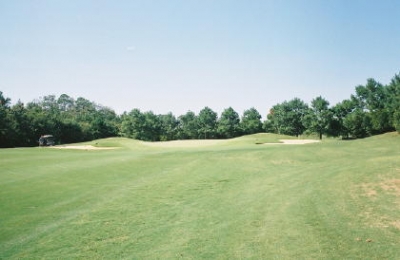 |
| Looks benign. But the tee is 606 yards and several lurking hazards away from this small, sharply contoured green. The par-5 sixth is The Carolina Club's No. 1 handicap hole. |
In addition to ownership and golf pros, the two golf clubs are also linked by their architect -- Russell Breeden. The prolific designer, who is credited with creating nearly 80 courses in the southeast, created this easy-to-play, tough-to-conquer layout just 13 miles from the Outer Banks beaches.
With five sets of tees that let players choose the appropriate level of challenge, The Carolina Club appeals to a wide range of players. The par-72 course measures nearly 7,000 yards from the back tees, but length isn't the only factor here. The course is exposed to the winds, affecting course management and shotmaking on nearly every hole, regardless of its direction.
Breeden moved just enough dirt to impart an interesting amount of roll to the fairways, which are blanketed with Tifway Bermuda grass. You won't find a profusion of bunkers at The Carolina Club. Most of the fairway hazards are off to the side and serve as aids to alignment. Green complexes are generally open to run-up shots from the fairway, with bunkers flanking the putting surfaces.
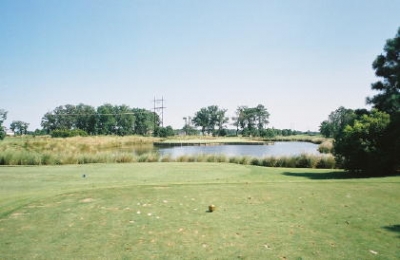 |
| The Carolina Club's signature hole: No. 7, a 166-yard, par-3 featuring an island green. |
The Carolina Club's generously proportioned greens feature L-93 bentgrass, which provides a dense carpet of fine-bladed grass. The superintendent and his crew keep the dance floors firm and fast, so players are well advised to position their approach shots below the hole as often as possible.
The course as it plays today is different from Breeden's original design. In the winter of 2001, Bob Moore was brought in to revamp the ninth, tenth and eighteenth holes.
According to Kinser, "The tenth hole had the same shape and pond that it has now, but the fairway landing area was too shallow. A straight drive could run through the dogleg, bringing the cart path and woods into play."
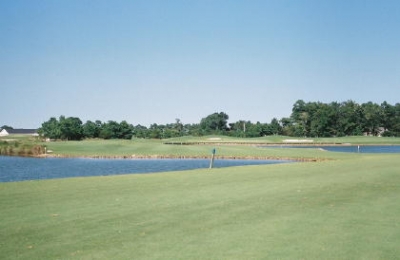 |
| Lay up to the left or go for it? Decisions abound on the 504-yard, par-5 ninth hole. |
Moore's solution was to extend the landing area and contour the fairway so that it would help contain tee shots. He also flashed up the edges of the bunkers on the left side of the fairway, providing more visibility and adding some dramatic flair. Extra tee boxes were added to give the staff greater flexibility in setting up the hole, which now features a 230-yard carry over the pond from the championship tee.
The biggest changes occurred on the ninth and eighteenth holes, both of which are par-5s. Moore reversed them to accommodate future development at the course. "We wanted No. 18 to finish by the permanent clubhouse that's in our long range plan," explained Kinser. "The reversal also made it more convenient for players to grab a drink or something to eat when they make the turn."
The old eighteenth hole is now the ninth. Moore widened the fairway and added a subtle second tier in the landing area that inhibits shots from running into a lateral water hazard on the left. The landing area for second shots was flattened so players wouldn't have to hit approach shots from a downhill lie to an elevated target. Lastly, Moore brought the green closer to the pond guarding the front of the green, resulting in a much more spectacular hole and not a little bit of danger for those who underclub their third shot or gamblers who go for it in two shots.
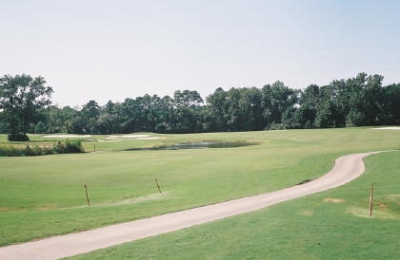 |
| A safe tee shot leaves a long approach, so haul out that big draw on the 428-yard, par-4 tenth hole. |
At the finishing hole, Moore flattened a crown in the landing area and widened it to increase visibility. Kinser says, "The second shot is crucial. If you go for the green in two, it's all carry to an elevated green guarded by deep bunkers. There's a little bailout room on the right, but you can't see the surface of the green from there. The safe shot is to lay up to an area on the left that's on the same level as the green."
Both nines at The Carolina Club offer memorable finishers, but there are plenty of notable golf holes before you get to them. On the front side, which features three par-3s, three par-4s and three par-5s, the 574-yard, par-5 fourth grabs your attention on the tee with three fairway bunkers that extend diagonally into the landing area from the right. Play left to avoid them and the hole is a true three-shotter. Fly over them and you're invited to reach the green in two.
The sixth hole, another par-5, also makes you think on the tee. A narrow finger of wetlands cuts across the fairway in the landing area. Depending on the tee location, wind direction and your nerve (or lack of it), you may want to lay up with your tee shot. It's a nearly 300-yard carry from the tips and 200+ from the middle tees.
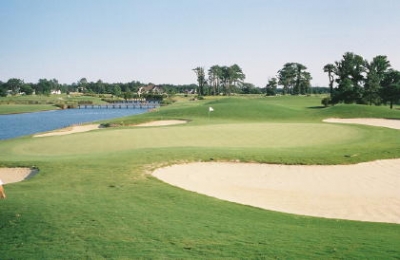 |
| The hazards are many, but the green is generously proportioned on the 219-yard, par-3 17th hole. |
Befitting the number-one handicap hole, the difficulty doesn't end with your tee shot. A deep drainage ditch runs up the left side of the fairway and a large pond lurks on the right. The widest spot in the fairway is at the 150-yard marker, which makes it a good place to land your second shot. The green is one of the smallest at The Carolina Club and it slopes away from the middle on both the front and back sides.
Breeden followed that monster with The Carolina Club's signature hole, a 166-yard, par-3 featuring an island green. If the wind was behind you on No. 6, it's in your face on No. 7. The green is fairly deep, so take enough club, but remember that the putting surface is aligned diagonally from left to right and play a little fade if you have one.
The inward nine opens with the previously described 428-yard, par-4 tenth and is followed by a straightforward par-4 and an innocuous 568-yard par-5. It gets interesting at the thirteenth, a devilish par-4 with a water hazard on the left side of the landing area that can't be seen from the tee, but can be reached with a hearty wallop.
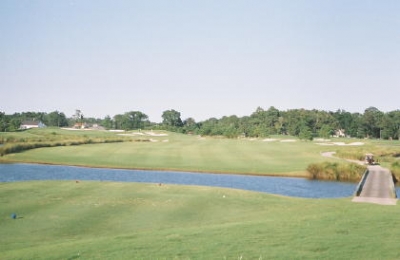 |
| Your approach to 18th green can go left, right or over the expansive bunkers. |
The Carolina Club's trio of finishing holes stands out for their variety and challenge. The sixteenth is a backbreaking 479-yard, par-4 featuring an undulating fairway and a long narrow green protected by a deep bunker on the front left side and another bunker on the front right side that is only slightly less intimidating.
The seventeenth hole, a 219-yard par-3 over water to an amphitheater green, can be a driver hole if the wind is in your face. The immense putting surface provides a confidence-inspiring target, but bunkers guard the three sides not protected by the pond in front.
Number eighteen is only 488 yards long from the back tees, but it's no pushover par-5. The water in front of the tee is more of a psychological hazard than a physical one and the landing area is wide and inviting. Decisions confront the player who successfully finds the fairway with his tee shot. Play for the green in regulation and a par, or even a birdie, is readily attainable.
Try to reach the green in two and the possibilities multiply from an eagle to bogie or worse. The eighteenth is only as difficult as you make it. If you play it with a plan in mind and execute well, you'll walk off The Carolina Club's final green with a good feeling.
Kinser calls the course "a hidden treasure" because its location in Currituck County means it is often less crowded than some of the beach golf courses during high tourist season. Regardless of when you play The Carolina Club, where the hidden treasure used to be potatoes, you'll discover a well-manicured, challenging and memorable golf experience.
The Carolina Club is a member of the Outer Banks Golf Association. Golf packages with overnight accommodations can be arranged by calling 800-916-6244. Information is available at www.outerbanksgolf.com.
Details:
The Carolina Club
127 Carolina Club Drive
Grandy, NC 27939
Phone: (252) 453-3588
Website: www.thecarolinaclub.com
Course Architects: Russell Breeden and Bob Moore
Head Golf Professional: Jason Drewry
Superintendent: Bobby Brown
|
Tees |
Yardage/Slope |
Rating |
|
Black |
6952/134 |
74.3 |
|
Gold |
6544/128 |
71.8 |
|
Blue |
6102/123 |
70.0 |
|
White |
5502/116 |
67.1 |
|
Red |
4855/121 |
68.2 |
Rates:
Rates vary according to season, ranging from $25 in winter to $89 in the summer season, which runs from June 16th to September 1st. Twilight and reduced replay rates are also available. All rates include golf cart and green fee. Rates are subject to change without notice. Consult the website for more information.| Related Links | Comments on this article? | |
|
Maryland National Golf Club Hollow Creek Golf Club Rocky Gap Resort PB Dye Golf Club in Ijamsville Whiskey Creek Golf Club |
E-mail Jeff Rendall, Editor: jrendall@golftheunitedstates.com |












